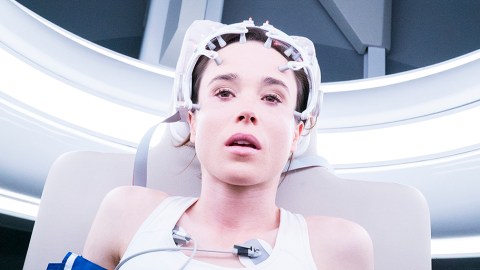“Flatliners:” deep questions, shallow answers

Michael Gibson, © 2017 CTMG, Inc.
“This isn’t science—this is pseudo-science!” a medical student yells as one of her colleagues attempts to induce cardiac arrest in another in an effort to replicate a near-death experience. Meanwhile, the other students wait to take pictures of what happens in her brain after she dies.
It is one of those rare moments where a movie—in this case, Flatliners, now playing nationwide—writes its own autopsy report.
But the biggest cinematic sin of Niels Arden Oplev’s new film isn’t that it plays fast and loose with its science. It is that it does so in service of a pointless remake that can’t decide what it wants to do with an implausible but admittedly dramatic premise.
When challenged by her attending physician to “move the dial on human knowledge,” Courtney (Ellen Page) devises her underground experiment. As Roger Ebert says of Joel Schumacher’s 1990 film of the same title, it is actually a great premise for a movie—a story in which characters “engage in a competition to see who can look God himself in the eye.” And it is, of course, a reflection of our desire to know what comes next, to discover what’s on the other side, just beyond sight.
But like its predecessor, Oplev’s film gets bogged down in the repetitions of the experiment. Since principal characters rarely die in mid-movie, there’s little suspense regarding whether the experiment will fail. And while movie technology has advanced in the last thirty years, the depictions of the afterlife are surprisingly banal.
Are these characters truly experiencing some sort of hereafter—or the fading signals of guilty memories and hopeful imaginations? The film hedges its bets. It also floats the idea that flatlining alters the students’ brains, giving them greater intelligence and memory, increasing libido, and making them less risk averse. But these effects appear temporary and the medical scientists, despite their initial motivation for doing the experiment, show little interest in observing, recording, or testing them.
Most medical science classifies what the students undergo as a “near-death experience.” Dr. Sam Parnia, however, prefers the term “after death.” A 2014 study that surveyed over 2000 patients in the United States, United Kingdom, and Austria indicated that 40 percent reported consciousness during a period of cardiac arrest. So were they really dead? It isn’t just scientists that have a hard time agreeing on a definition of “deceased.” Legal and religious criteria for whether someone is dead have varied over time and between cultures.
But Flatliners does explore the question of just how far we’re willing to go to determine whether there’s an afterlife. What risks are we willing to take? How far should we push boundaries in the name of scientific inquiry? Are some things simply not meant to be fully understood?
But it’s not the Big Questions that ultimately sink Flatliners. It’s the lack of them. It’s the lack of curiosity about what the experience of the afterlife signifies. Dr. Bruce Greyson, a psychiatrist at the University of Virginia, looks at near-death experiences not to win theological or scientific arguments but to understand what motivates living people to change their behavior.
In the film, characters who flatline are plagued by visions of people they have wronged in life, and their visions continue to impose on them post-resuscitation until they take a fierce moral inventory and offer amends (or at least apologies) to the people they have wronged. That their visions go away after they do so suggests they are products of a guilty conscience rather than of cosmic or karmic justice. Thus the moral of the story is that we are happier and better people when we take responsibility for the wrongs we have done and apologize to the people to whom we have done them.
Do we really need to kill ourselves and take post-death PET scans to learn that lesson?
The post “Flatliners:” Deep Questions, Shallow Answers appeared first on ORBITER.





